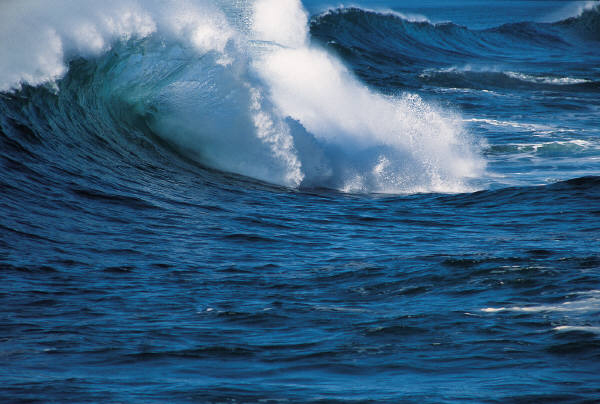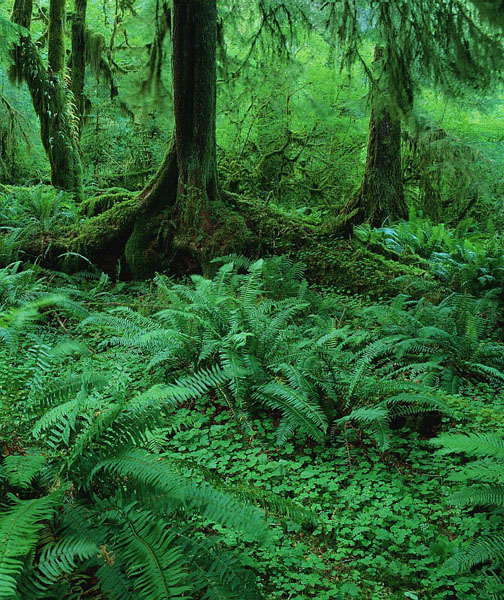Sinks of Carbon Dioxide
Processes or regions that predominately absorb atmospheric carbon dioxide are referred to as sinks. Carbon dioxide may be removed from the atmosphere when it is used by plants and algae for photosynthesis, dissolved in water, or deposited in the sediments on land or in the ocean.
Photosynthesis
Green plants use water from the soil and CO2 from the atmosphere to make carbohydrates (glucose) and oxygen in the process of photosynthesis. In the ocean, algae carry on the same process. During photosynthesis, plants and algae convert the radiant energy of the sun into chemical energy to make the carbohydrates (glucose) and produce oxygen as a byproduct. Plants and algae make more glucose in photosynthesis than they consume in respiration. The excess glucose produced by these photosynthetic organisms becomes the food consumed by animals.
carbon dioxide + water + energy → glucose + oxygen
Oxygen is then used by the animals and plants to oxidize food. This provides the animals and plants with energy. So when animals consume plants or they consume other animals that eat plants, they use the carbohydrates (glucose) as a source of energy.
Dissolution in Water
Carbon dioxide can also be absorbed in the surface water of the ocean. As the concentration of carbon dioxide in the atmosphere increases, some of this carbon dioxide will be dissolved in the oceans. When the water is cooler than the atmosphere, more carbon dioxide can be dissolved. Gases are more soluble in cooler water than in warmer water due to the Second Law of Thermodynamics. Gases are exchanged through the ocean surface until equilibrium is reached.
When carbon dioxide combines with water, it forms carbonic acid.
dissolved CO2 + water → carbonic acid
The oceans provide a huge reservoir of carbon. Scientists estimate that the oceans hold more than 50 times the total atmospheric carbon dioxide content. However, as the ocean temperatures rise over the next centuries, surface waters will begin to release carbon dioxide and the oceans will become a source instead of a sink.
Ocean acidification is a very alarming problem for Earth’s oceans, and ultimately, life on Earth. As more carbon dioxide gas is absorbed in the ocean, the pH of the ocean decreases (becomes more acidic), which lowers the availability of the carbonate ions needed by organisms that build shells. This impact on organisms that build skeletons and shells out of calcium carbonate will profoundly affect ocean ecosystem and food webs. You will learn more about ocean acidification in the module on impacts of climate change.
Deposition as Carbonate Sediments
Rainwater dissolves atmospheric carbon dioxide producing carbonic acid. Carbonic acid also reacts with rock through chemical weathering to form bicarbonate ions (HCO3-) that are
carried by groundwater and streams to the ocean. Marine organisms use bicarbonate and the calcium (Ca2+) in seawater to produce the calcium carbonate (CaCO3) that they need to make their shells, skeletons, and spines. A coral reef is one example – a coral reef is a huge colony of organisms that use calcium carbonate to build a hard outer skeleton.
When marine organisms die, their remains slowly sink and reach the ocean floor. Over time, these organic materials are compressed by their own weight and other sediments, gradually changing into carbonate rock, such as limestone.
Formation of Fossil Fuels
Some carbon from organic matter is deposited as sediments. This carbon rich sediment eventually is buried and can be changed into fossil fuels (coal, oil, or natural gas) over very long periods of time. Fossil fuels formed hundreds of millions of years ago during the Carboniferous Period (about 300 million years ago) before the dinosaurs roamed the planet.
During this time, Earth was a much warmer and swampier place. When ancient marine organisms died, they decomposed and became buried under layers of mud, rock, sand, and shallow seas. Over the millions of years that passed, these ancient plants and animals slowly decomposed and formed fossil fuels. Coal formed from the remains of trees, ferns, and plants in swampy areas. Oil and natural gas were created from organisms that lived in rivers or shallow seas. Heat, pressure, and bacteria acted to compress and change the organic material first into oil, and later into natural gas, which formed deeper underground.
Today, we are basically tapping energy that was originally stored hundreds of millions of years ago.
Watch Episode 2: Global Warming, It's All About Carbon.
NPR's Robert Krulwich and Odd Todd, in partnership with Wild Chronicles, present an animated cartoon series on the atom at the heart of global warming: carbon. Episode 2: Carbon's special knack for bonding.




